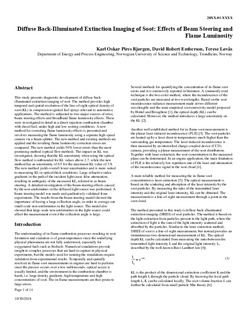Diffuse Back-Illuminated Extinction Imaging of Soot: Effects of Beam Steering and Flame Luminosity
Journal article, Peer reviewed
Accepted version

Åpne
Permanent lenke
http://hdl.handle.net/11250/2624326Utgivelsesdato
2019Metadata
Vis full innførselSamlinger
Originalversjon
10.4271/2019-01-0011Sammendrag
This study presents diagnostic development of diffuse backilluminated extinction imaging of soot. The method provides high temporal and spatial resolution of the line-of-sight optical density of soot (KL) in compression-ignited fuel sprays relevant to automotive applications. The method is subjected to two major sources of error, beam steering effects and broadband flame luminosity effects. These were investigated in detail in a direct injection combustion chamber with diesel fuel, under high and low sooting conditions. A new method for correcting flame luminosity effects is presented and involves measuring the flame luminosity using a separate high-speed camera via a beam splitter. The new method and existing methods are applied and the resulting flame luminosity correction errors are compared. The new method yields 50% lower errors than the most promising method (optical flow method). The impact on KL was investigated, showing that the KL uncertainty when using the optical flow method is unbounded for KL values above 2.7, while the new method has an uncertainty of 0.5 for the maximum KL value of 3.8. The new method yields overall lower uncertainties and is more suited to measuring KL in optical thick conditions. Large refractive index gradients in the path of the incident light cause false attenuation, resulting in ambiguity of the measured KL, referred to as beam steering. A detailed investigation of the beam steering effects caused by the non-uniformities in the diffused light source was performed. A beam steering model was made and qualitatively validated from experiments. The results from the beam steering model showed the importance of having a large collection angle, in order to average out small-scale non-uniformities in the light source. The model also showed that large-scale non-uniformities in the light source could affect the measurement even if the collection angle is large.